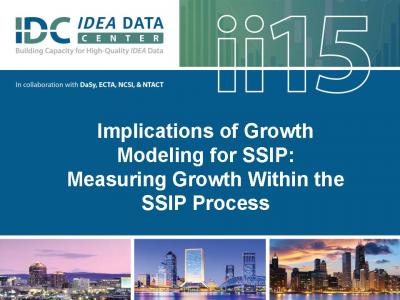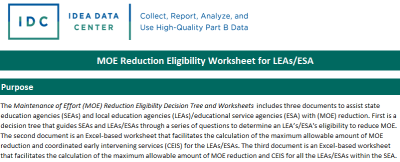Site Search
Results 92 - 98 of 608
Format: Presentations
Implications of Growth Modeling for SSIP: Measuring Growth Within the SSIP ProcessGrowth models provide states with an option for determining how to measure progress toward a student level SIMR outcome. Participants discussed and provided input into development of an IDC white paper that focuses on different growth model approaches, the data requirements, and analytic approach in order to use a growth model approach to measure growth toward a SIMR student outcome. Currently, the white papers is in draft form and undergoing revisions based on input from the field. The published paper will be posted to the IDC Resource Library and affiliated as a related resource to the handouts already posted for this session.
Format: Presentations
It Starts at Preschool: Aligning 619 Activities With the B SIMRThe presentation provides strategies that are important to providing high-quality preschool programs. Specifically, the information focuses on how high-quality preschool programs support improvement in the Part B SIMR. The presentation includes strategies that ensure high-quality early childhood programs as a critical first step toward later school success.
Format: Presentations
State Part B Teams Discuss Their Experiences With the SSIP and SIMR ProcessThe presentation focuses on experiences of State Part B teams in analyzing data, selecting their SIMR, and completing their SSIP. Guiding questions help states connect Phase I and Phase II planning.
Format: Presentations
Using Implementation Science in Phases II and IIIUse of implementation science is critical in planning and implementing systemic improvement. This information explores how to operationalize the components of implementation science and how to select, implement, and scale-up chosen evidence-based practices. Helpful handouts are included.
Format: Applications and Spreadsheets
Maintenance of Effort (MOE) Reduction Eligibility Decision TreeThe Maintenance of Effort (MOE) Reduction Eligibility Decision Tree guides SEAs and LEAs/ESAs through a series of questions to determine an LEA’s/ESA's eligibility to reduce MOE.
Format: Applications and Spreadsheets
Maintenance of Effort (MOE) Reduction Eligibility WorksheetsThe Maintenance of Effort (MOE) Reduction Eligibility Worksheets includes two documents to assist SEAs and LEAs/ESAs with MOE reduction. The first is an Excel-based worksheet that facilitates the calculation of the maximum allowable amount of MOE reduction and CEIS for the LEA/ESAs. The second document is an Excel-based worksheet that facilitates the calculation of the maximum allowable amount of MOE reduction and CEIS for all the LEAs/ESAs within the SEA.
Format: Presentations
Part B Transition Indicators: Supporting States in the SSIPThe National Post-School Outcomes Center, in collaboration with IDC, provided a picture of post-school outcomes for youth with disabilities over the last four years based on Indicator 14 data. Presenters discussed methods states use to collect these data. To further states' work in RDA and improve results, presenters provided information about resources and TA that support states in examining the transition indicators as stakeholders work through the three phases of the SSIP.








